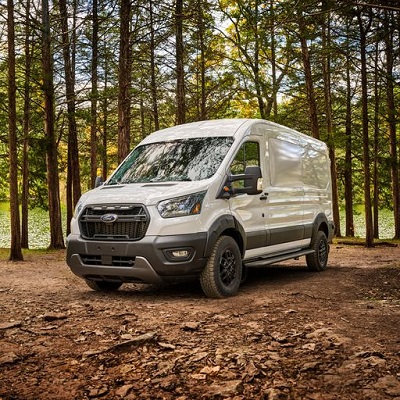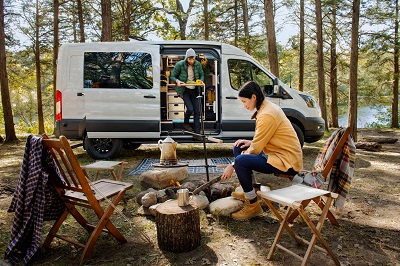
Ford is bringing its Transit commercial customizable van chassis to the RV market with the Ford Transit Trail adventure Type B van. The Transit trail includes off-road features as well as advanced technology standard.
Tapping into Van Life
On the pathway to designing the new Transit Trail, the company interviewed Type B van customers and discovered two consumer segments: The “do-it-yourself” van outfitters and consumers who want to buy a Type B van pre-built, ready for adventuring and backed by an OEM warranty.
According to Jennifer Mitchell, Ford Transit brand manager, consumers in the pre-built segment purchase from motorhome distributors “so they do not have to wait for their adventure to begin.”
Both groups are turning towards buying new vehicles rather than upfitting old ones.
Consumers are “rapidly moving away from buying an old van and outfitting it,” said Ray Eyles, chief program engineer, Ford Transit North America “What they find is… hey, my biggest nightmare is I have invested thousands of hours and dollars into an outfit and then a week later the van dies.”
Offroad Design
Ford redesigned Ford Transit’s chassis parts to increase its off-road capability with larger tires and better ground clearance. Ford worked to capture the rugged look Type B motorhome consumers say they want.
The new chassis includes a 3.5-liter EcoBoost V6 engine that produces 310 horsepower and 400 pound-feet of torque, mated to a 10-speed automatic transmission. Also included is all-wheel drive, with five selectable drive modes: “Normal,” “Eco,” “Mud/Ruts,” “Tow/Haul” and “Slippery.”
“So basically, the base powertrain out of the factory is what you need to get to the trailhead,” Eyles said. “It also comes with all the kinds of driver assist technologies that the premium customer would expect. We have pre-collision assist and lane keeping assist and we have options for reverse side and front sensing and for blind spot indication.”
Ford chose larger 245-millimeter Goodyear Wrangler Workhorse all-terrain tires on the Transit Trail to give the van a higher clearance, more rugged appearance, better handling and noise reduction, Eyles said.
“One of the other things that is really interesting about the larger tires is, it is surprising how much difference it makes the ride,” Eyles said “The reason is, just with the larger tires, all of those small imperfections both on the road and off-road, both with the larger rolling circumference and the softer sidewalls, you just get a real improvement on the ride and it feels like a very different vehicle than the regular commercial Transit.”
Because the tires increased in size, Ford had to move the tires about 1.5 inches out to maintain the body and suspension clearances and the steering lock. To achieve this, the company selected 16-inch black alloy wheels with a different offset. The changes increased the front vehicle track width by 2.75 inches to 80 inches wide.
Consumers requested more lift on their Type B van, so Ford also installed a lift kit. The kit, plus the larger tires, gives the Ford Transit Trail 3.5 inches additional ground clearance. New, full-length slider-style running boards help RVers to access the vehicle.
The company installed a black grill on the Transit Trail front. The grill includes integrated marker lamps, a regulatory requirement for the 80-inch track width, and black high-intensity discharge headlamps. A skid plate-style front bumper, splash guards, wheel arch cladding and front wheel arch liners protect and add to the off-road look of the vehicle.
Technology and Options
Transit Trail is available in medium- and high-roof cargo van configurations, including an extended-length high-roof model that provides up to 487 cubic feet of cargo space. Both high-roof variants provide full standing room to people 6-feet, 5-inches tall. The cargo area floor in the extended-length model stretches more than 14 feet.
medium- and high-roof cargo van configurations, including an extended-length high-roof model that provides up to 487 cubic feet of cargo space. Both high-roof variants provide full standing room to people 6-feet, 5-inches tall. The cargo area floor in the extended-length model stretches more than 14 feet.
A heavy-duty trailer package comes standard on the Transit Trail for hauling a boat, four-wheelers, snowmobiles or other adventure toys.
The vehicle includes intelligent access with push-button start to let RVers unlock, lock and start the vehicle when the key fob is close to or inside the Transit Trail.
The Sync 4 connectivity system powers the vehicle’s 12-inch touchscreen center. The system includes SiriusXM with 360L, HD radio, a high-resolution digital camera, as well as 110-volt, 12-volt and USB outlets.
“Probably the most critical thing our customers asked for, is they wanted (the new Transit Trail) to be OEM, because they wanted it to be signed off by us to our standards for durability and safety and covered by the Ford factory warranty,” Eyles said.
Consumers also wanted to buy a Ford because they know the brand has an extensive dealer network, he said.
The Transit Trail is backed by Ford’s three-year/36,000-mile bumper-to-bumper warranty.
Meeting demand
Ford does not anticipate supply chain shortage issues preventing deliveries to OEMs, Eyles said. The Ford Transit contains fewer chips than some vehicles, he said, making the Ford Transit “a little bit protected” from shortages that are affecting other vehicle lines, he said.
“Right now, I do not feel any real concern about the ability to supply chassis. We are supplying chassis right now,” Eyles said. “Our biggest constraint right now is that our vehicle is in such high demand.”
To accommodate increased orders, Ford will be hiring additional workers and adding a third production shift at its Kansas City, Missouri, plant next year, Eyles said.




